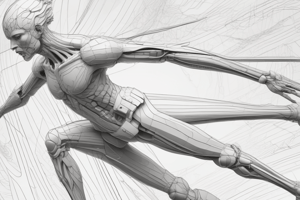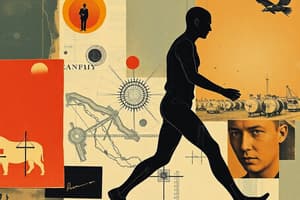Podcast
Questions and Answers
What is the primary purpose of engaging trunk muscles before lifting?
What is the primary purpose of engaging trunk muscles before lifting?
- To maintain balance during the lift
- To increase flexibility in the back
- To stabilize the trunk for effective extremity movement (correct)
- To reduce lifting time
Which of the following is NOT a recommended practice when draping a patient?
Which of the following is NOT a recommended practice when draping a patient?
- Providing adequate coverage and warmth
- Obtaining consent before removing clothing
- Using layered draping techniques to minimize exposure
- Leaving the patient exposed for extended periods (correct)
What should be done to maintain normal spinal curvature while lifting?
What should be done to maintain normal spinal curvature while lifting?
- Look downwards at the load
- Twist the trunk at the hips
- Maintain lordosis (correct)
- Flex the back at the waist
When should you consider using a team lift or mechanical devices?
When should you consider using a team lift or mechanical devices?
What is the primary concern when moving a patient with attached lines and tubes?
What is the primary concern when moving a patient with attached lines and tubes?
What is one of the key considerations when draping a patient in a physical therapy setting?
What is one of the key considerations when draping a patient in a physical therapy setting?
Which vital sign monitor is specifically used to assess heart rhythm?
Which vital sign monitor is specifically used to assess heart rhythm?
What must be done before initiating any therapeutic activities for a patient with a nasogastric feeding tube?
What must be done before initiating any therapeutic activities for a patient with a nasogastric feeding tube?
Why is it important to position the patient upright or semi-reclined after feeding through a nasogastric tube?
Why is it important to position the patient upright or semi-reclined after feeding through a nasogastric tube?
Which of the following factors are NOT magnified in an ICU environment?
Which of the following factors are NOT magnified in an ICU environment?
What is the impact of a larger base of support on stability?
What is the impact of a larger base of support on stability?
Which statement accurately describes the center of mass?
Which statement accurately describes the center of mass?
What role does the plumb line serve in body mechanics?
What role does the plumb line serve in body mechanics?
How can proper body mechanics reduce the risk of injury during lifting?
How can proper body mechanics reduce the risk of injury during lifting?
Which principle is NOT part of the 5 L’s to lifting?
Which principle is NOT part of the 5 L’s to lifting?
Flashcards are hidden until you start studying
Study Notes
Center of Mass
- Center of mass is the central point where gravity acts on a body or segment, often referred to as the center of gravity.
- In a standing position, the center of mass is located in the pelvic region, anterior to the S2 vertebra.
- The center of mass shifts when body segments change position, weight is added or removed, or the object's position changes.
Base of Support
- The base of support is the area where an object makes contact with its supporting surface.
- A larger base of support increases stability as it allows more space for the center of mass to be within the base of support, and it decreases stress on the clinician.
- A smaller base of support decreases stability, leading to a higher risk of the center of mass being beyond the base of support, increasing stress on the clinician.
Posture
- A plumb line is an imaginary line that represents the ideal alignment of the body in an upright position.
- The plumb line should pass through specific landmarks in a lateral view, including the external auditory meatus, acromioclavicular joint, midway through the trunk, greater trochanter, fibular head, and anterior to the lateral malleoli.
Stability and Mobility
- Stability refers to how well something stays put.
- Mobility refers to how easily something can move or be moved.
- Stability and mobility are related to the center of mass and base of support.
Promoting Stability and Mobility
- To promote stability, increase the base of support, ensure the line of gravity is at or near the center of the base of support, shorten the distance between the center of mass and base of support, and lower the center of mass closer to the base of support.
- To promote mobility, decrease the base of support, allow the line of gravity to move beyond the center of the base of support, and increase the distance of the center of mass above the base of support.
Body Mechanics
- Body mechanics refers to the coordinated effort between the musculoskeletal and nervous systems to maintain balance, posture, and body alignment during tasks.
- Proper body mechanics can reduce stress on body structures, promote efficient and safe movements, maintain control and balance, conserve energy, and support effective respiratory and cardiopulmonary function.
- Correct posture and body alignment help maintain the normal spinal curves.
Basics of Lifting Mechanics
- The 5 L’s to lifting principle:
- Load: Plan ahead by estimating the load and clearing the path of travel.
- Lever: Consider the distance from your center of gravity to the object.
- Lordosis: Maintain proper posture and normal lumbar curvature.
- Legs: Use legs to lift.
- Lungs: Exhale during lifting, avoiding the Valsalva maneuver.
Load
- Plan ahead by mentally and physically preparing for the lift, ensuring a safe environment, considering patient safety and contraindications, determining the need for individual or team lift, and communicating with the patient and team.
Lever
- Position yourself close to the load for stability and reduced muscle activity.
- Maintain a wide base of support by standing with feet apart, one foot slightly in front of the other, and toes pointed slightly outward.
Lordosis
- Maintain normal spinal curvature, a slight inward curve of the low back, and look ahead rather than downwards.
- Keep your chest facing forward and avoid twisting at the trunk, particularly if flexed.
- Pivot on feet or take small steps to rotate the body.
Legs
- Bend at hips and knees for a squat lift, lowering the body's center of mass for stability.
- Lift with an upright trunk, normal spinal curvature, and engage trunk muscles before lifting.
- For pushing, utilize a wider base of support, lower center of mass, and larger muscles.
Legs Variations
- Half Kneel (Tripod Position): Begin behind the object, remain upright, place the object on your knee, and push through the forward leg.
- Golfer’s Lift: Used for lighter objects, lift by flexing at the hip and reaching forward while resting on a single leg.
Lungs
- Exhale during exertion to prevent the Valsalva maneuver and reduce intra-abdominal pressure.
No Skipping Leg Day
- Maintain your lifting equipment, strengthen your muscles, improve flexibility, and engage in aerobic conditioning.
- Avoid prolonged sitting and prioritize regular movement.
Draping
- Draping procedures in physical therapy settings maintain patient privacy, modesty, and dignity.
- The general procedures for draping involve:
- Before Treatment: Plan ahead, cover treatment areas, obtain consent, provide temporary clothing, and ensure privacy.
- During Treatment: Provide initial overall coverage, expose only the necessary area, secure edges, minimize exposure time, and layer draping materials.
- After Treatment: Provide specific dressing instructions, ensure privacy, dispose of draping materials, and sanitize.
Draping Purposes
- For the clinician: Necessary access to specific body areas for examination and intervention.
- For the patient: Protection of privacy, modesty, dignity, cultural safety, warmth, comfort, protection of vulnerable skin (wounds, surgical sites, scars, neurologically impaired areas), and protection of clothes.
Maximize Comfort and Dignity
- Utilize verbal and non-verbal communication, obtain consent, provide adequate coverage, and ensure privacy (secured door, curtain, room divider, leave room upon request, suggest assistance).
- Provide clinical attire, cover clothes with temporary linens, minimize exposure (amount of area exposed and length of time exposed), and layer draping materials.
- Secure edges to increase a sense of security by tucking along the body and clothes.
Patient Positioning
- Supine: Examination of the anterior trunk and lower extremities.
- Prone: Examination of the posterior neck, trunk, and lower body.
- Sidelying: For individuals unable to lie prone.
- Sitting: Linens may slide off, so layer and tuck linens.
Adjusting Positions
- Provide additional linens for coverage during transition.
- Hold coverage in place during transition and re-secure once repositioned.
Lines, Tubes, and Drains
- Be aware of common lines and tubes utilized for medical care to ensure safe mobility and avoid kinking, pulling, stretching, or dislodging.
- Be aware of potential challenges such as pain, neuromuscular impairments, sedation, and side effects from medications, especially in an ICU environment.
Vital Signs Monitoring
- Be aware of ECG leads, blood pressure cuffs, pulse oximeters, temperature monitors, and respiratory rates.
Lines and Tubes; Head and Neck
- Nasogastric (NG) Feeding Tube: Inserted through the nose, esophagus, and into the stomach for administering liquid nutrition.
- Nasoduodenal Tube: Similar to the NG tube, but ends in the duodenum.
- Nasal Cannula: Flexible tube delivering supplemental oxygen, used for conditions requiring additional oxygen.
- Tracheostomy: Alternative way of breathing through a tube inserted into the trachea, used for airway blockage, mucus clearing difficulties, and long-term breathing support.
Lines and Tubes; Upper Extremity
- PICC Line (Peripherally Inserted Central Catheter): Longer and thicker central venous catheter inserted peripherally in an extremity.
- Peripheral IV (Intravenous Device): Placed peripherally on an extremity, used for drawing blood and administering treatments.
Lines and Tubes; Torso
- Percutaneous Endoscopic Gastrostomy (PEG) Tube/G-tube: Feeding tube inserted into the stomach or duodenum, requiring an upright position during feeding.
- Chest Tube: Flexible plastic tube inserted into the chest wall and pleural space to remove air or fluid.
- Ostomy Bag: Surgically created opening in the abdomen to collect waste or urine, often with a bag placed over it.
Drains
- Jackson Pratt: Thin, flexible tube connected to a bulb, collecting fluids draining from wounds post-surgery.
- Hemovac Drain: Similar to Jackson Pratt but larger, collecting fluids post-surgery.
- Wound Vac: Vacuum assisted closure used for burns, trauma, wounds, and pressure ulcers.
- Foley Catheter: Tube inserted into the bladder for drainage, with a collection bag hung below bladder level.
Movement Precautions and Contraindications
- Contraindication: Patient conditions that make therapy inappropriate.
- Precautions: Protective measures minimizing the risk of injury, reinjury, or stress.
Contraindication for Exercise and Physical Activity
- Medically unstable conditions, such as unstable vital signs, unstable angina, uncontrolled arrhythmias, uncompensated congestive heart failure, unstable blood glucose, severe dehydration, severe anemia, low oxygen saturation.
Activity Precautions
- Nasogastric Tube (NGT): Risk of aspiration pneumonia, HOB at 30-45 degrees, avoid supine or prone during feeding, and wait 30-60 minutes after feeding before laying supine or prone.
- Sternal Precautions: No lifting, pushing, pulling, or driving, limit overhead reach, splint chest when coughing.
- Modified Sternal Precautions ("Move in the Tube"): Biomechanical principles to reduce stress, functional approach, keep upper arms close to the body during rolling, standing, and lifting.
- Abdominal Precautions: Minimal trunk extension and rotation, no lifting, log rolling, use of abdominal binder, and self-splinting.
- Spinal Precautions: No bending, lifting, twisting, log rolling for bed mobility.
- Hip Precautions (THA - Posterior): Prevent dislocation, no hip flexion beyond 90 degrees or 70 degrees, no internal rotation beyond neutral, and no adduction beyond neutral.
- Hip Precautions (THA - Anterior): Caution with excessive hip extension and external rotation.
Introduction to Functional Movement and Functional Levels
- Functional Movement: Movement patterns essential for daily life and physical activities.
- Functional Assessment: Used to establish a baseline status, set function-oriented goals, assess outcomes, determine placement decisions, evaluate safety, support intervention effectiveness, and document for payer requirements.
Activities of Daily Living (ADLs)
- Basic ADLs: Routine daily activities like feeding, ambulating, transferring, toileting, bathing, continence management, and dressing.
- Instrumental ADLs (IADLs): Activities necessary for independent living, such as companionship, transportation, shopping, meal preparation, housekeeping, medication management, finances, and communication.
Functional Levels
- Independent (I): Functions safely and efficiently without assistance, cueing, or supervision.
- Modified Independent (Mod I): Functions safely alone with assistive devices or extra time without assistance, cueing, or supervision.
- Supervision (S): Functions safely with monitoring for safety, potentially requiring devices, extra time, verbal cueing, or set-up assistance.
- Minimal Assistance (Min A): Patient completes >75% of the task with physical assistance.
- Contact Guard Assistance (CGA): Patient completes >75% of the task with physical assistance (touching).
- Moderate Assistance (Mod A): Patient completes 50-74% of the task with physical assistance.
- Maximum Assistance (Max A): Patient completes 25-49% of the task with physical assistance.
- Total Assistance/Dependent (Total A): Patient completes <25% of the task with physical assistance.
- No Tactile Assistance: No physical contact from the clinician.
- Some Tactile Cueing: Minimal physical contact to assist with movement.
Studying That Suits You
Use AI to generate personalized quizzes and flashcards to suit your learning preferences.




